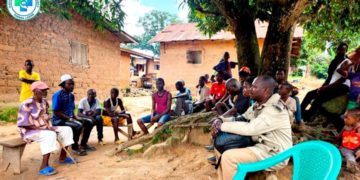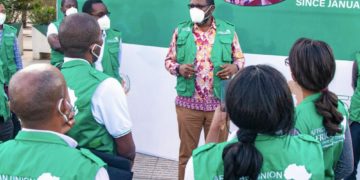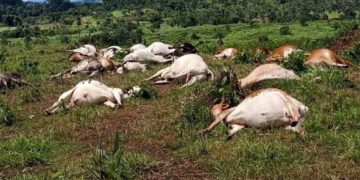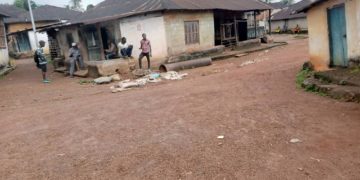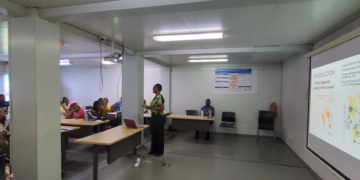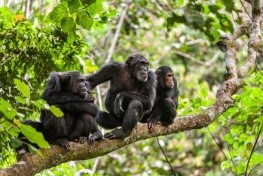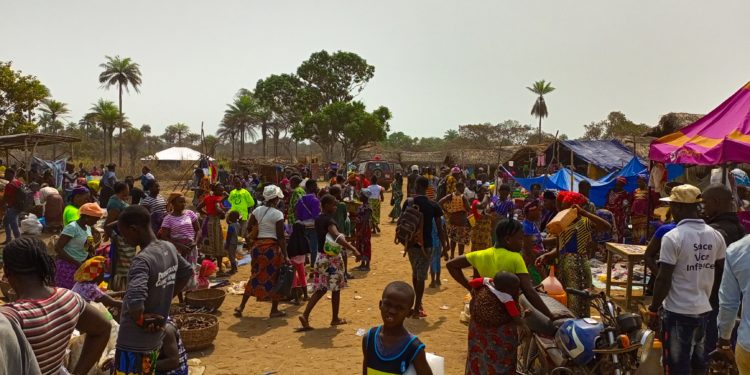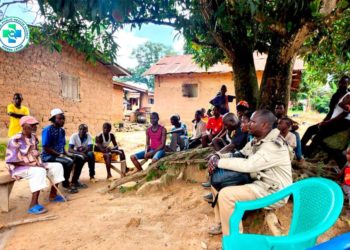The people of Kpaka Chiefdom on Sunday, March 20th celebrated the first anniversary of the reopening of their weekly trade fair commonly called Luma.
Celebrations marking the landmark event took place at Gbamgbaima, the location of the weekly market, bringing together natives and well-wishers from neighboring chiefdoms.
Gbamgbaima was reopened in 2021, over three decades after it was shut down due to the 1991-2002 civil war.
Located at an intersection between two Chiefdoms – Kpaka and Galliness – Gbamgbaima is one of about half a dozen weekly markets within Pujehun District, and it is the last to reopen since the war ended 20 years ago. Lack of a market in the area meant that the people of Kpaka Chiefdom, with a population of over 16,000, according to the 2015 Population and Housing Census, had to endure over 30 years of struggle to either sell their agricultural produce or buy even the most basic stuff for their daily needs.
Kpaka is one of 12 chiefdoms that make up Pujehin, which is one of four districts that constitute the southern region of Sierra Leone.
Pujehun is one of the most deprived parts of Sierra Leone in terms of socioeconomic development. Consequently, according to the Sierra Leone Multidimensional Poverty Index 2019, the district ranks at the top with the highest incidence of multidimensional poverty in the country.
Jeneba J. Bangura, the brain behind the reopening of Bamgbaima, says her goal was to create opportunities for her people by fostering trade as a way of fighting poverty.
Bangura, who is the Deputy Commissioner of the National Revenue Authority (NRA), says this is her version of development.
“Before now our people have been traveling from here to Bo, to Jendema, to Kenema, to just make sure that they get the food stuff and other commodities they need, stuff like salt, Maggie, onions, etc,” she says.
“Now that the trade fair is open, instead of them going, the businesses are coming. And for that I am pleased that they are overjoyed. And I am just hopeful that we will get the support that we have been getting from the chiefdoms that we have been working with,” she adds.
From stuff as important as fish, which is a luxury to many locals despite its abundance in the region, to stuff as rare as electronic gadgets, almost everything is available in the once abandoned market.
Pujehun, because of its close proximity to Liberia, was one of the most affected districts during the Sierra Leone civil war, which spilled over from the neighboring country. Gbamgbama became a barren land as a result of the closure of the market.
When it was reopened last year, it had only about three thatched structures serving as stalls and shops. Twelve months after, it has now grown to about two dozen structures. There are even two Court Barrays and some dwelling homes.
“A year has made a difference in the lives of the people,” says Bangura, who provided funds and coordinated efforts between local authorities of the neighboring chiefdoms to reopening of the market.
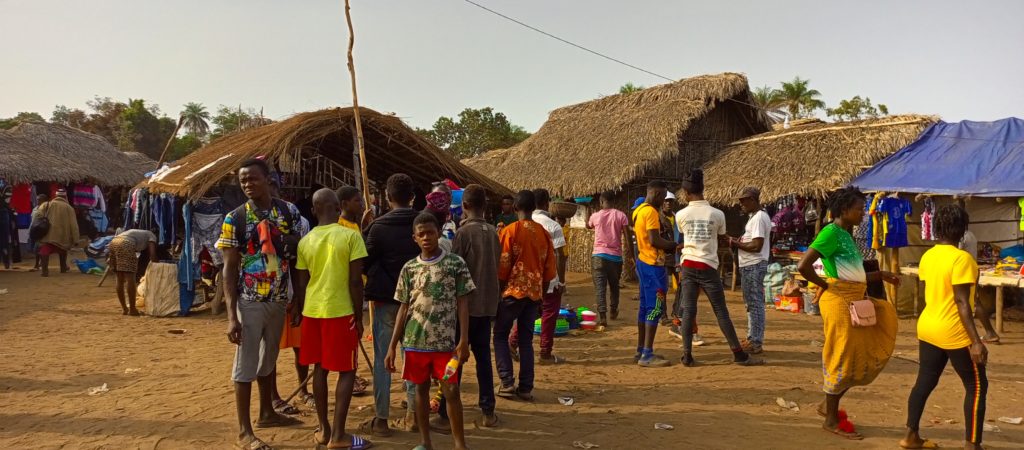
Bangura is a native of Njala Kpka, one of the most important villages in Kpaka Chiefdom. Njala Kpaka is the headquarters of Saba Section, which comprises 10 communities. It is the closest community to Gbamgbaima, which stands on a land that belong to both Kpaka and Galliness. This is the reason it is called Gbamgbaima, which loosely translates as ‘open space’ in the predominant Mende tribe of the region.
Although the official commemoration of Gbamgbaima fell on Sunday, March 20, the celebrations began a day earlier, with musical carnival involving modern and traditional sounds.
Besides the fanfare, the event was used to sensitize the people on the importance of tax collection as well as societal issues hampering development in that part of the country, like Sexual and Gender Based Violence (SGBV). Pujehun has one of the highest rates of SGBV cases in the country, official data show.
The main commemorative event held in the market square attracted speeches from major community leaders from across the district, including the Paramount Chiefs of both Kpaka and Galliness, the Member of Parliament of the constituency, and the Councillor of the area.
The Bank of Sierra Leone’s new currency was introduced to the locals, for most of them for the first time.
PC John Sallia Rogers, Paramount Chief of Kpaka Chiefdom, witnessed the reopening of the fair in 2021. He recalls that there were only three hurts.
“Today, as you can see, there are over 20 stalls here. It shows that the business is growing,” he says, noting that people come from far beyond the two chiefdoms, as far as Liberia.
In spite of its aloofness, Pujehun is strategically located at the border with Liberia, and it is home to some of the best beaches outside Freetown. The district is also home to some of Sierra Leone’s most important fishing centers, like Sulima, which is in Sorogbema Chief which, alongside Mano Sakrim and Yakemu Kpukumu Krim (YKK), shares close borders with Kpaka.
Several rivers flow in between these neighboring chiefdoms, including the Moa, which are all endowed with vast reserves of fish. Some of the communities in the region are also located at the mouth of the Atlantic Ocean.
All of the fish from these places now have a market at Gbamgbaima, says Idrissa Massaquoi, a native of Njala Kpaka, who travelled from his base in Kenema to grace the commemoration.
Mr Massaquoi says fishermen from these neighboring chiefdoms used to take their fish towards the Liberian end in search of market.
Rice and Cassava are also popular agricultural produces from this part of Pujehun.
“Hundreds of people are coming to do business here now. Some even come from as far as Bo, Kenema and Mano River Areas,” says Massaquoi.
For Paramount Chief Jojo Massaquoi of Galliness, Gbamgbaima will galvanize the relationship between the peoples of the two chiefdoms. She says she is not surprised at the rapid growth of the Luma because the people had been longing for it.
“We used to find it difficult here to have our needs, people travel all the way to Jendema, Solima, a Luma near Bumpe, Bonda Pee and Banda Juma Sowa lumas. Now we have all those things here,” she says.

In the course of the three-day commemoration, from Saturday March 19 to Luma Day, Monday March 21, life was restored in the nearby communities, including Njala Kpaka.
A football match was hosted as part of the commemoration. Named ‘President Bio Trophy,’ the match featured the host chiefdom Kpaka and Galliness. Kpaka defeated Galliness 1:0.
Ms Bangura says the trophy is not only meant to commemorate the President but also to bring joy to the youth of the area.
“Football also brings the people together,” she says.
“It takes very little to make our people happy. Development starts small. Development doesn’t mean building skyscrapers. All they need is to bring these to them, reopening of the fairs,” she says.
According to Bangura, President Bio doesn’t have to bring development to grassroots himself, they as his “foot soldiers” are expected to do the ground work and bring “what we have brought to these people.”
The goal of the people Kpaka Chiefdom is for Gbamgbaima to become the biggest Luma in the region.
But to get to that dream, there is a lot of work to be done in terms of infrastructure to enhance the business climate of the region. The road network, for one, needs serious touching.
This part of Pujehun is highly sandy. Vehicular movement is largely hindered due to the large deposits of sand which causes nightmare for motorists and riders.
There is also the need for WASH facilities at the Luma.
Francis B. Amara, a native of Galliness Chiefdom, serves as clerk for the committee that administers the Luma. He is also one of its tax collectors. Francis sums up the concerns of the people.
“Accessing mobile phone network is a huge problem for us. We have to search for network under trees and other high-altitude points,” he says.
All the community people say they want is a network pole to enhance their communication.
For lighting, Mrs Bangura and her team have embarked on a temporary measure by providing a few solar powered poles positioned at strategic locations within the market space and one at the riverside linking Gbamgbaima to Njala Pkapa.
Bangura says her appeal with authorities at the Road Maintenance Fund paved way for ongoing road construction works along the Blama Massaquoi – Kpaka connecting road.
The project entails grading of the road and construction of about 20 culverts. The second phase of the project is expected to branch off to Lia Kpaka, another important fishing community.
“We are still pleading with both the local government and central government to continue supporting us with the road. As far as WASH is concerned, it’s a perennial problem. We are talking to different stakeholders, including NACSA, to help,” says Bangura, noting that because of the number of people that visit the Luma, it is extremely important that WASH is taken care of.
“Otherwise there is going to be other health problems to deal with,” she says.

